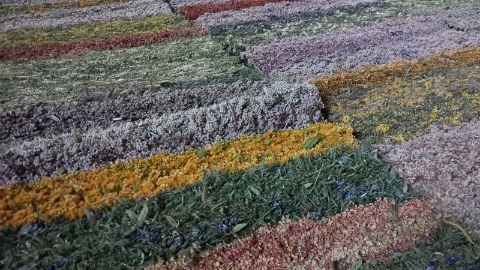Zoia Lebedeva

Zoia Lebedeva, трава-foreva (herbs foreva) / шесть точек зрения (eight points of view) (2023). Courtesy Zoia Lebedeva
Zoia Lebedeva has developed a unique technique for weaving tapestries from plants and grasses, which she terms ‘flortextile’. In their fragile and impermanent qualities, these organic pieces defy conventional artwork logic, bridging contemporary art with vernacular folk culture and ancestral sacred rituals. Born in a village in Udmurtia, Lebedeva received training in textile crafts. In the 1990s, she began creating her flortextiles utilizing various species like wormwood, mint, sweet clover, oregano, yarrow, tansy, goldenrod, and other herbs. Treating plants as sacred entities, she conceived special weaving rites and rituals. Lebedeva has always been fascinated by the metaphor of textile as language and text, and at the age of 63 she enrolled at Tartu University to pursue studies in Slavic philology. For the exhibition, the artist weaved six herbal tapestries, bringing their haptic and olfactory qualities into dialogue with the concrete modernist interiors of HKW’s building.
Work in the exhibition: трава-foreva (herbs foreva) / шесть точек зрения (eight points of view) (2023), 6 woven herb carpets, 50 × 450 cm each. Courtesy of the artist